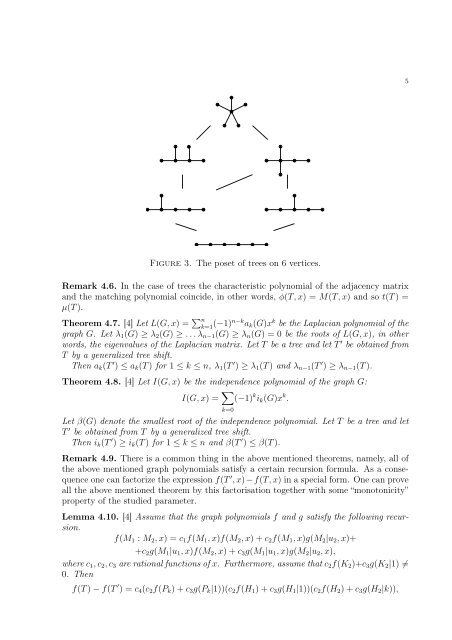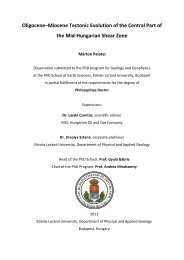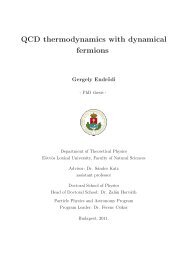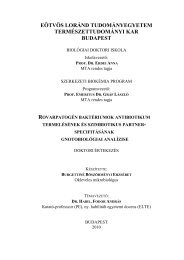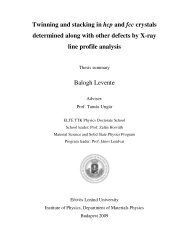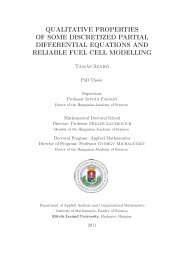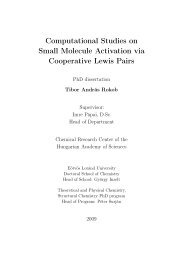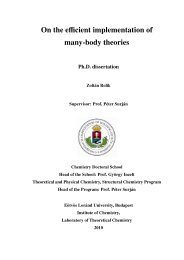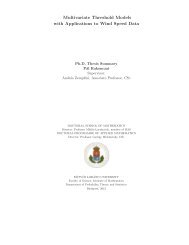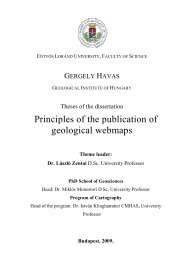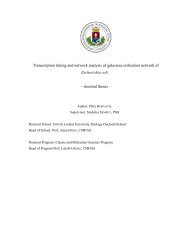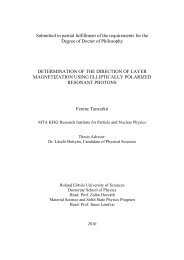Graph Polynomials and Graph Transformations in ... - ELTE TTK TEO
Graph Polynomials and Graph Transformations in ... - ELTE TTK TEO
Graph Polynomials and Graph Transformations in ... - ELTE TTK TEO
You also want an ePaper? Increase the reach of your titles
YUMPU automatically turns print PDFs into web optimized ePapers that Google loves.
5Figure 3. The poset of trees on 6 vertices.Remark 4.6. In the case of trees the characteristic polynomial of the adjacency matrix<strong>and</strong> the match<strong>in</strong>g polynomial co<strong>in</strong>cide, <strong>in</strong> other words, φ(T,x) = M(T,x) <strong>and</strong> so t(T) =µ(T).Theorem 4.7. [4] Let L(G,x) = ∑ nk=1 (−1)n−k a k (G)x k be the Laplacian polynomial of thegraph G. Let λ 1 (G) ≥ λ 2 (G) ≥ ...λ n−1 (G) ≥ λ n (G) = 0 be the roots of L(G,x), <strong>in</strong> otherwords, the eigenvalues of the Laplacian matrix. Let T be a tree <strong>and</strong> let T ′ be obta<strong>in</strong>ed fromT by a generalized tree shift.Then a k (T ′ ) ≤ a k (T) for 1 ≤ k ≤ n, λ 1 (T ′ ) ≥ λ 1 (T) <strong>and</strong> λ n−1 (T ′ ) ≥ λ n−1 (T).Theorem 4.8. [4] Let I(G,x) be the <strong>in</strong>dependence polynomial of the graph G:I(G,x) = ∑ k=0(−1) k i k (G)x k .Let β(G) denote the smallest root of the <strong>in</strong>dependence polynomial. Let T be a tree <strong>and</strong> letT ′ be obta<strong>in</strong>ed from T by a generalized tree shift.Then i k (T ′ ) ≥ i k (T) for 1 ≤ k ≤ n <strong>and</strong> β(T ′ ) ≤ β(T).Remark 4.9. There is a common th<strong>in</strong>g <strong>in</strong> the above mentioned theorems, namely, all ofthe above mentioned graph polynomials satisfy a certa<strong>in</strong> recursion formula. As a consequenceone can factorize the expression f(T ′ ,x)−f(T,x) <strong>in</strong> a special form. One can proveall the above mentioned theorem by this factorisation together with some “monotonicity”property of the studied parameter.Lemma 4.10. [4] Assume that the graph polynomials f <strong>and</strong> g satisfy the follow<strong>in</strong>g recursion.f(M 1 : M 2 ,x) = c 1 f(M 1 ,x)f(M 2 ,x) + c 2 f(M 1 ,x)g(M 2 |u 2 ,x)++c 2 g(M 1 |u 1 ,x)f(M 2 ,x) + c 3 g(M 1 |u 1 ,x)g(M 2 |u 2 ,x),where c 1 ,c 2 ,c 3 are rational functions of x. Furthermore, assume that c 2 f(K 2 )+c 3 g(K 2 |1) ≠0. Thenf(T) − f(T ′ ) = c 4 (c 2 f(P k ) + c 3 g(P k |1))(c 2 f(H 1 ) + c 3 g(H 1 |1))(c 2 f(H 2 ) + c 3 g(H 2 |k)),


